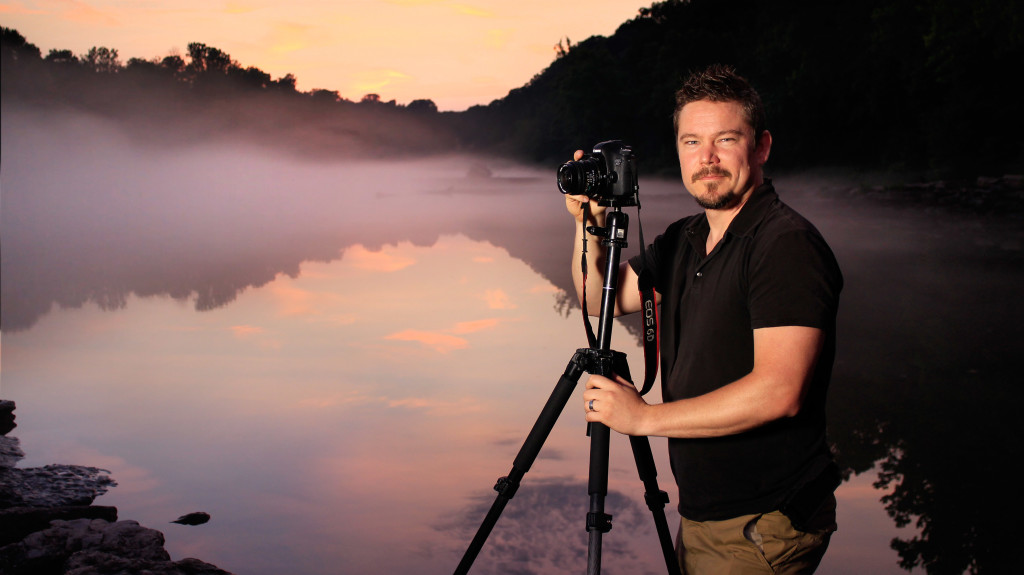C’est toujours un grand plaisir de rencontrer des personnes qui utilisent la réalité augmentée pour faire passer des messages et sublimer leur pratiques artistiques. Je vous propose donc aujourd’hui un cours entretien avec Edward C. Robison III, photographe au coeur de l’Arkansas américain et utilisateurs heureux de la réalité augmentée !
Hello Edward, we are very happy to welcome you on augmented-reality.fr ! Could you please introduce yourself?
My name is Edward C. Robison III, I am photographer, cinematographer, and digital artist from Eureka Springs, Arkansas- USA. My personal work focuses on the Natural Landscape, but I also work as a freelance commercial photographer and cinematographer specializing in travel and tourism industry, and hi-res photography for art museums.

Could you explain us why do you use augmented reality in your work ?

In 2014 I wanted to create a photography book about the Ozarks- a geographic natural region in the United States. At that time I was questioning whether people were still buying picture books, since most forms of media and photography were already digital. I was also doing a lot of time-lapse photography at the time. I thought it would be interesting to somehow fuse the traditional photography with time-lapse photography in book form and I looked at several different techniques including Photicular and Lenticular prints to animate the book. At that time my son was 12 years old and had an app on his Iphone that triggered 3D content using a large printed black and white “QR” code. So I began to research Augmented Reality and only found a couple of books that utilized this new smartphone enabled technology. I decided to give AR a try and I launched a Kickstarter campaign to fund my book project:
The project was a success! I wanted to build a custom app for the book, but at that time it was above my skill level and Kickstarter wouldn’t allow me to campaign for funds that would be used to build an app. So I decided to go with HP’s Aurasma app (Now called Reveal) to build my Augmented Reality experiences. “Ozark Landscapes” An Augmented Reality Project book was really focused on bringing the images in the book to life using overlays of time-lapse photography and live video.
Just before the book launched I discovered photogrammetry. Photogrammetry is a technique used to create 3D models of real-world objects using photography. I was immediately hooked and I incorporated a couple of very rough 3D model overlays in the Ozark Landscapes book.
After launching my book and watching users interact with it, I realized that Aurasma was clunky to use and had a horrible user interface, so I set out to build my own app for future projects.
Is it complicated to use AR ? Do you make all by yourself or do you work with other people ? Do you have a “favorite” tool ?

In 2017 I launched a new book project focused on the picturesque town where I live – Eureka Springs. “Eureka Springs” An Augmented Reality Project was a bit different than my Ozark Landscapes book. I wanted every image in the book to be interactive, and I also wanted most of them to contain photogrammetry 3D models. For this book I custom built my own app using the Unity Vuforia development kit. There was a huge learning curve! My son helped me a lot with the code, and I watched a ton of youtube videos and read a lot of help forums. At the time I started to develop the first app there was very little support, and oftentimes I was trying to do things that very few people had tried to do before… or at least finding support forums and videos would prove to be sometimes almost impossible.
One of the most difficult issues of building an AR app is keeping the file sizes down, especially if you want to incorporate complex 3D models and also have a large number of triggers. One of the most frustrating issues I encountered was splitting an app for Android- as you are limited to 100 megabytes on the Google Play Store!
Also in 2017 I co-authored a Shakespearean AR walking tour in Eureka Springs. My friend MacKenzie Doss came to me with a concept to film live actors and have them “appear” at different locations around town using Augmented Reality technology. To accomplish this we filmed the actors on green screen and keyed out the background. We then created an Alpha Shader to give the illusion that the actors were standing in the same space as the spectator using the app. Signs and markers of places to stand to view the play were placed around town to guide the viewer throughout the play. We found that inconsistent outdoor lighting and natural seasonal changes caused issues with app recognition. Unfortunately it wasn’t until the end of the project that Apple announced their AR kit-with ground plane tracking, which would have immensely helped the tracking of the green screened actors to the outdoor scenes.

How people react in front of your work ? Is it “natural” for them to use it?
Watching users interact with my Augmented Reality books has been very interesting! When I launched my first book Ozark Landscapes, I spent a lot of time educating the public. Very few people had seen anything like it. Most people were amazed and quite a few called it Harry Potter magic!
When it comes to users experiencing it on their own there is definitely a generational gap. Younger people, even if they have never seen Augmented Reality before, quickly get the idea and begin to move their devices around the image to experience different angles, etc. (especially when viewing 3D models) The older generation tends to hold the device still and wait for things to happen. This works fine if a time-lapse or video is triggered, but severely limits their experience with 3D models. I have also had folks in the oldest generation say things like “Your photos are great on their own. They don’t need this! (AR)” To which I respond, it is still just a picture book like any other you have seen before, there is just extra “hidden” content for people that like to explore and experience something new. 🙂
What are your next projects with augmented reality ? Are there any limits you want to break ?
I am currently working on new interactive art pieces for my upcoming exhibition at the Fort Smith Regional Art Museum in Arkansas entitled: “The Nature of Photography – From Traditional to Augmented Reality”. The exhibition will chronicle my 25+ year photographic and artistic journey during a time of revolution in the world of photography. The exhibition illustrates how technology can influence art and even drive the artistic process. For the exhibition I have fused traditional landscape photography with new media work which incorporates elements of Video, 3D Modeling, Augmented and Virtual Realities.
For this exhibition, one of the most exciting things I have been working on is creating virtual 3D “dioramas” that set down inside the artwork or book page. The “virtual dioramas” incorporate elements of 360 photographs, photogrammetry models, and particle generators to enhance the realism of the triggered scene. This technique is really pushing my personal skills and boundaries, but I feel I am creating something new with Augmented Reality that people haven’t really seen before.
I am really excited to see where this technology is headed, and I truly believe it is the future of technology!
Many thanks Edward for your time!
To see all his works, please go the the website https://www.edwardcrobisoniii.com
Grégory MAUBON est consultant indépendant en réalité augmentée (animateur et conférencier) depuis 2008, où il a créé www.augmented-reality.fr et fondé en 2010 RA'pro (l'association francophone de promotion de la réalité augmentée). Il a aidé de nombreuses entreprises (dans plusieurs domaines) à définir précisément leurs besoins en réalité augmentée et les a accompagnées dans la mise en œuvre.

